Take a look at DIFM’s recent 100-hectare corn seed rate per hectare trial design, located in Buenos Aires province, Argentina, and satellite imagery taken during the growing season. 
Tag Archives: argentina
Annual Advisory Board Report
DIFM in Argentina
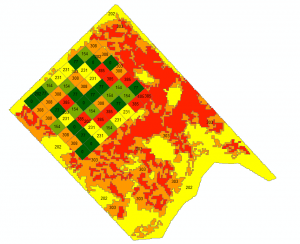
In Argentina we conducted experiments during the 2016-2017 growing season in two contrasting areas of the country: Buenos Aires and in Chaco province. Experiments in Buenos Aires have been harvested and had 18 trials total, with nitrogen and plant density done in separate trials. These fields are approximately 200 acres on average, with experiments taking place on 40 acres.
Visiting Scholar at the U of I
Image
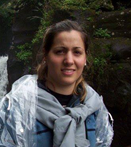 Paula Girón is a visiting scholar at the U of I and a master’s candidate in soil science at the University of Buenos Aires. She is a researcher at the Agricultural Experiment Station General Villegas of the Nation Institute of Agricultural Technology. Girón is interested in site-specific management of nitrogen in maize in the northwest of Buenos Aires.
Paula Girón is a visiting scholar at the U of I and a master’s candidate in soil science at the University of Buenos Aires. She is a researcher at the Agricultural Experiment Station General Villegas of the Nation Institute of Agricultural Technology. Girón is interested in site-specific management of nitrogen in maize in the northwest of Buenos Aires.
Personnel Changes: New Faces On the DIFM Project
Due to their significant effort to date, we have officially added three scholars to the DIFM project. Dr. Nicolas Martin, Assistant Professor in Quantitative Agronomy in the Department of Crop Sciences, will participate in DIFM trial design and statistical analysis of the data generated.
Dr. Haiying Tao will work with DIFM trial designers to take the practical aspects of running trials in the Pacific Northwest, and will supervise the implementation of Washington and Idaho wheat trials. Laila Puntel will communicate with cooperating researchers and participating farmers in Argentina, and will concentrate on experimental design and data analytics from those trials.
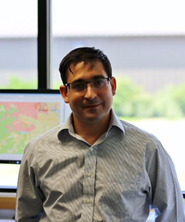
Nicolas Martin’s undergraduate degree is in Agronomy at University of Mar del Plata; his graduate studies at the University of Illinois focused on studying Soil-Plant relationships with multivariate analysis and spatial statistics. After graduation, Martin worked for more than 10 years in the seed industry developing drought-tolerant corn hybrids and using large geospatial datasets to position trials and soybean varieties in the marketplace. As an Assistant Professor at the University of Illinois, he hopes to improve the long-term profitability and stability of cropping systems by exploring applications of quantitative methods on big data. He is interested in interdisciplinary efforts to expand the frontiers of agricultural research and study effective approaches to implement new insights and discoveries in agricultural decisions and operations.
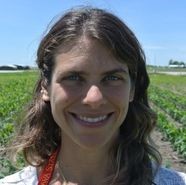
Laila Puntel graduated from the National University of Mar del Plata in Balcarce (Buenos Aires) with a BSc in Agronomy. She got a MS degree in Crop Production and Physiology at Iowa State University and is currently pursuing a PhD degree. Her research focuses on customizing a cropping system model as an in-season tool to support management decision-making and means of improving nitrogen management decisions in maize production systems. She is the co-founder of and leads research and development at Clarion, a precision agriculture consulting company in Argentina, where she has worked with site-specific nutrient management based on soil mapping and analysis.
 Haiying Tao is an assistant professor of Soil Fertility and Residue Management in the Department of Crop and Soil Sciences at WSU. Her research programs focus on fertility management and strategies to improve soil health for WA agricultural systems. She is currently leading an effort to develop a farmer’s network, which will be a platform for information sharing, participatory learning and on-farm research using precision agricultural technologies.
Haiying Tao is an assistant professor of Soil Fertility and Residue Management in the Department of Crop and Soil Sciences at WSU. Her research programs focus on fertility management and strategies to improve soil health for WA agricultural systems. She is currently leading an effort to develop a farmer’s network, which will be a platform for information sharing, participatory learning and on-farm research using precision agricultural technologies.
Visiting Researchers
Two Professors of agricultural statistics from the National University of Cordoba, Argentina, visited the University of Illinois campus in July. Prof. Cecilia Bruno spent three weeks, and Prof Monica Balzarini spent one week. They worked with existing data, and began to conceptualize statistical computer programs to semi-automatize our methods of data and economic analysis. The long-run goal here is to make it feasible for DIFM to be able to analyze data coming from hundreds, or even thousands, of field trials every year, and in this way provide farmers from all over the world with data-based management advice.
On July 5, David Bullock, Taro Mieno, Nicolas Martin, and Monica Balzarini and Ceci Bruno met in Ankeny, Iowa with Scott Nelson and Peter Kyveryga. Nelson is the Director of the Iowa Soybean Association’s On-Farm Network. Kyveryga is the Director of ISA’s Research Analytics program. Discussions were held about working with ISA to run DIFM trials on twelve fields in 2018.
DIFM in Argentina
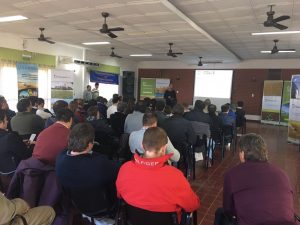
On July 19 in Nueve de Julio, Argentina, Laila Puntel and David Bullock each gave a presentation to a group of 60 farmers and crop consultants. Puntel set up the half-day meeting, working with the Argentine firm Grobocopatel and their farmer-clients. Their main purpose was to publicize the project, and to recruit participating farmers for our trials in South America.
On July 20, Puntel and Bullock held meetings in Buenos Aires with the agribusiness Yara, which does business in the fertilizer industry around the world. They spoke with people in their Latin American research and development team, explaining the DIFM project’s research, and searching for common interests.
Puntel and Bullock also met with representatives from CREA, which is an Argentine institution that works with around 2,000 farmers, often conducting on-farm research. Those discussions also went well, and our project will be continuing them over the coming months.

